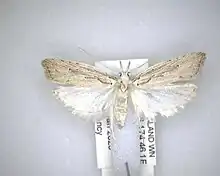| Heterocrossa exochana | |
|---|---|
 | |
| Scientific classification | |
| Domain: | Eukaryota |
| Kingdom: | Animalia |
| Phylum: | Arthropoda |
| Class: | Insecta |
| Order: | Lepidoptera |
| Family: | Carposinidae |
| Genus: | Heterocrossa |
| Species: | H. exochana |
| Binomial name | |
| Heterocrossa exochana | |
| Synonyms[2] | |
| |
Heterocrossa exochana is a species of moth in the family Carposinidae. It is endemic to New Zealand and has been observed in the North and South Islands. The larvae of this species feed on the fruits of Muehlenbeckia species. The adult is on the wing from September until May and are attracted to light.
Taxonomy
This species was described by Edward Meyrick in 1888 using material he collected in Nelson in January.[2][3] In 1922 Meyrick classified Heterocrossa as a synonym of the genus Carposina.[4][5] George Hudson, following Meyrick, discussed and illustrated this species in his 1928 publication The Butterflies and Moths of New Zealand under the name Carposina exochana.[6] Later that same year Alfred Philpott examined the genitalia of the males of the species.[7] In 1978 Elwood Zimmerman argued that the genus Heterocrassa should not be a synonym of Carposina as the genitalia of the species within the genus Heterocrassa are distinctive.[4] In 1988 John S. Dugdale assigned the species back to the genus Heterocrossa.[2] The female holotype specimen is held at the Natural History Museum, London.[2]
Description
.jpg.webp)
This species was described by Meyrick as follows:
Female. — 21 mm. Head and thorax ochreous-white. Palpi with upper longitudinal half ochreous-white, lower dark fuscous. Antennas, abdomen, and legs ochreous-whitish, anterior legs suffused with dark fuscous. Forewings elongate, scarcely dilated, costa moderately arched, apex round-pointed, hind-margin faintly sinuate, rather strongly oblique ; pale whitish-ochreous ; about ten small irregular scattered black dots in disc ; a subterminal series of irregular cloudy black dots, obsolete towards costa and inner margin : cilia pale whitish-ochreous. Hindwings and cilia ochreous-whitish.[3]
H. exochana can possibly be confused with H. morbida but the male of H. exochana has much longer porrected palpi.[8]
Distribution
H. exochana is endemic to New Zealand and has been observed in both the North and South Islands.[9][1] Other than its type locality of Nelson, H. exochana has been collected in Masterton, Wellington, Christchurch, Dunedin and Invercargill.[6] The species has also been collected in Fiordland[10] and Hawkes Bay.[11] Hudson regarded it as an uncommon species.[6]
Biology and behaviour
The adults of this moth are on the wing from September to May.[6] The adult moths are attracted to light.[6]
Host species
_Meisn._(AM_AK359802-3).jpg.webp)
The larvae feed on the fruits of Muehlenbeckia species.[12]
References
- 1 2 "Heterocrossa exochana Meyrick, 1888". www.nzor.org.nz. Landcare Research New Zealand Ltd. Retrieved 13 June 2018.
- 1 2 3 4 Dugdale, J. S. (1988). "Lepidoptera – annotated catalogue, and keys to family-group taxa" (PDF). Fauna of New Zealand. 14: 1–269. ISBN 0477025188. Archived from the original (PDF) on 27 January 2019. Retrieved 12 June 2018.
- 1 2 Meyrick, Edward (1888). "Notes on New Zealand Tortricina". Transactions and Proceedings of the New Zealand Institute. 20: 73–76 – via Biodiversity Heritage Library.
- 1 2 Zimmerman, Elwood (1978). Insects of Hawaii. Vol. 9. Hawaii: University of Hawaii Press. p. 797. hdl:10125/7338. ISBN 9780824804879.
- ↑ Meyrick, Edward (1922). "Lepidoptera Heterocera Fam. Carposinidiae". Genera Insectorum. fasc.176–180: 1–235 – via Biodiversity Heritage Library.
- 1 2 3 4 5 Hudson, G. V. (1928). The Butterflies and Moths of New Zealand. Wellington: Ferguson & Osborn Ltd. p. 217. OCLC 25449322.
- ↑ Alfred Philpott (1928). "The Male Genitalia of the New Zealand Carposinidae". Transactions and Proceedings of the New Zealand Institute. 59: 476–480. ISSN 1176-6158. Wikidata Q113369538.
- ↑ Edward Meyrick (10 June 1912). "Descriptions of New Zealand Lepidoptera". Transactions and Proceedings of the New Zealand Institute. 44: 120. ISSN 1176-6158. Wikidata Q109393380.
- ↑ Gordon, Dennis P., ed. (2010). New Zealand inventory of biodiversity: Kingdom animalia: chaetognatha, ecdysozoa, ichnofossils. Vol. 2. p. 457. ISBN 978-1-877257-93-3. OCLC 973607714. OL 25288394M. Wikidata Q45922947.
- ↑ Clarke, Charles E. (1933). "The Lepidoptera of the Te Anau-Manapouri lakes districts". Transactions and Proceedings of the Institute of New Zealand. 63: 112–132.
- ↑ Davies, T. H. (1973). "List of Lepidoptera collected in areas surrounding Hastings and Napier". New Zealand Entomologist. 5 (2): 204–216. doi:10.1080/00779962.1973.9723002.
- ↑ "PlantSynz - Invertebrate herbivore biodiversity assessment tool: Database". plant-synz.landcareresearch.co.nz. Retrieved 8 July 2018.